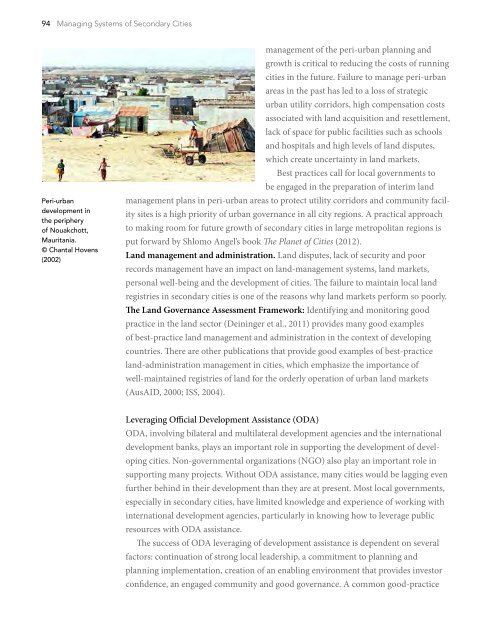DYhWN
DYhWN
DYhWN
You also want an ePaper? Increase the reach of your titles
YUMPU automatically turns print PDFs into web optimized ePapers that Google loves.
94 Managing Systems of Secondary CitiesPeri-urbandevelopment inthe peripheryof Nouakchott,Mauritania.© Chantal Hovens(2002)management of the peri-urban planning andgrowth is critical to reducing the costs of runningcities in the future. Failure to manage peri-urbanareas in the past has led to a loss of strategicurban utility corridors, high compensation costsassociated with land acquisition and resettlement,lack of space for public facilities such as schoolsand hospitals and high levels of land disputes,which create uncertainty in land markets.Best practices call for local governments tobe engaged in the preparation of interim landmanagement plans in peri-urban areas to protect utility corridors and community facilitysites is a high priority of urban governance in all city regions. A practical approachto making room for future growth of secondary cities in large metropolitan regions isput forward by Shlomo Angel’s book The Planet of Cities (2012).Land management and administration. Land disputes, lack of security and poorrecords management have an impact on land-management systems, land markets,personal well-being and the development of cities. The failure to maintain local landregistries in secondary cities is one of the reasons why land markets perform so poorly.The Land Governance Assessment Framework: Identifying and monitoring goodpractice in the land sector (Deininger et al., 2011) provides many good examplesof best-practice land management and administration in the context of developingcountries. There are other publications that provide good examples of best-practiceland-administration management in cities, which emphasize the importance ofwell-maintained registries of land for the orderly operation of urban land markets(AusAID, 2000; ISS, 2004).Leveraging Official Development Assistance (ODA)ODA, involving bilateral and multilateral development agencies and the internationaldevelopment banks, plays an important role in supporting the development of developingcities. Non-governmental organizations (NGO) also play an important role insupporting many projects. Without ODA assistance, many cities would be lagging evenfurther behind in their development than they are at present. Most local governments,especially in secondary cities, have limited knowledge and experience of working withinternational development agencies, particularly in knowing how to leverage publicresources with ODA assistance.The success of ODA leveraging of development assistance is dependent on severalfactors: continuation of strong local leadership, a commitment to planning andplanning implementation, creation of an enabling environment that provides investorconfidence, an engaged community and good governance. A common good-practice


